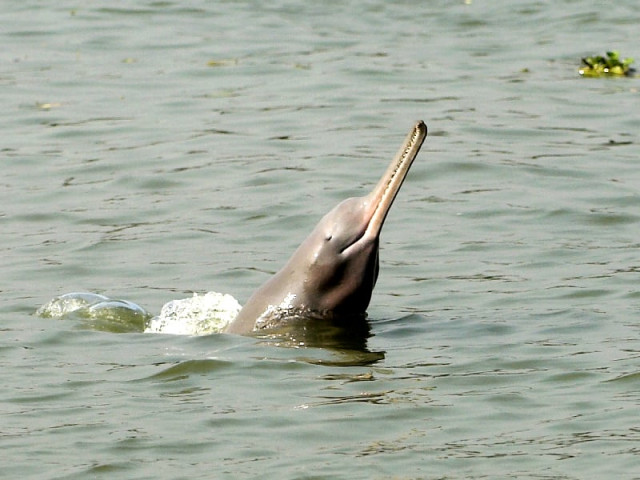Blind dolphin emerges stronger after floods
WWF report indicates that floods may have increased the habitat of the Indus River Dolphin.

Indus Dolphin. PHOTO: FILE
The 2010 epic floods hit hard, destroying everything in their wake.
At that time, it was difficult – impossible, in fact – to see a silver lining of any sort.
And yet, according to a 2011 and 2012 survey report recently published by WWF Pakistan, the floods may have been a blessing in disguise for the Indus Dolphin. They are speculated to be one of the reasons behind an increase in the dolphin distribution, and may have even aided in multiplying the population in certain river sections.
Fruitful findings
The floods did result in a number of dolphin mortalities, due to stranding, because of which it was initially presumed that the dolphin population had decreased. However, this report illustrates how an increased water extent in the main survey channel may have allowed the mammals to move along the river and establish sub populations, thereby spreading out and adding to the overall population.
“Initial findings after the flood may very well have been misleading,” says Uzma Khan, Director Biodiversity at WWF-Pakistan. “This is because with more water there was a low detection rate of the Indus Dolphin.”

In 2001, the first study was conducted covering the entire distribution range of Indus Dolphins between Jinnah and Kotri barrages, and the results revealed that an estimated population of 1,100 dolphins existed in the river. From that time period, it is a feat that this endangered species has not decreased in number.
“In the 2011 dolphin population survey, the total abundance of 1,452 dolphins was estimated in the Indus River,” states Uzma Noureen, of Indus River Dolphin Project.
The 2011 and 2012 survey was conducted in collaboration with the World Wide Fund for Nature-Pakistan (WWF-Pakistan), International Union for Conservation of Nature, Cetacean Specialist Group, Sindh, Punjab and Khyber-Pakhtunkhwa wildlife departments, Zoological Survey Department of Karachi, Adventure Foundation Pakistan, Nature Conservation Pakistan and the Conservation and Hunting Association of Pakistan.
Wandering in other waters
The report states that a number of active channels after high floods provided the dolphin population an opportunity to disperse. Thus, with less food competition and new habitats created, the dolphins thrived.
Supposedly, opened barrage gates during the floods also facilitated dolphin movement in both up and downstream directions. Consequently, dolphin presence in the areas such as the Taunsa Guddu river section and Sukkur Kotri section spiked, while it dwindled in the Guddu Sukkur river section.
Maintaining the momentum
According to Khan, effective conservation of the elusive dolphin is a need of the hour. This is no time for complacency. The river section between Guddu and Sukkur barrages represents the highest sub-population for Sindh, whereas the second largest sub-population is found between Taunsa and Guddu barrages.
“A stretch of the Indus River between Taunsa and Guddu Barrages should be made into a protected area,” says Khan.
Khan is right to be cautious. Despite the positives indicated by the report, an increased mortality in Guddu–Sukkur river section is alarming and certainly demands national scale conservation initiatives.
Furthermore, the mortality of this mammal is directly associated with the rise in illicit fishing practices.
“It is crucial to amend the regulation of fisheries and control illegal fishing activities,” adds Khan. “Provincial fisheries legislations need serious attention and should be revised for overall benefit of the Indus River freshwater ecosystem.”
In this vein, she says, although the entire river stretch should be a reserve for dolphins, it is important to have areas designated as dolphin sanctuaries, with absolutely no fishing allowed.
“The monitoring of canals and active channels along the Indus River should be improved to find stranded dolphins in time and the dolphin rescue team should be well equipped and trained in capturing and trans-locating stranded animals safely,” says Khan.
Importance of sustainability
Like other manmade threats to the dolphin, that of unsustainable development cannot be undermined.
“Unsustainable builds, including constructed dams and barrages for water storage and irrigation purposes, along with other anthropogenic activities are a serious threat to the ecological health and biodiversity associated with rivers,” explains Khan. “The Indus River System in Pakistan is no exception and is facing the same challenges. The unique biodiversity associated with the freshwater ecosystem is at risk.”
Published in The Express Tribune, August 4th, 2013.



















COMMENTS
Comments are moderated and generally will be posted if they are on-topic and not abusive.
For more information, please see our Comments FAQ